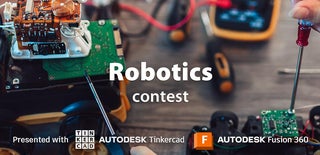Introduction: Create Your Combat Robot
Combat robots are machines designed to face each other in competitions of wits, skill, and power. These robots can have different shapes, sizes, weapons and strategies, making each fight unique and exciting. The objective of this project is to design, build and program a combat robot that is capable of participating in tournaments, causing interest to grow in this area where people develop their capabilities and attract the minds of the future and have a greater boom both robotics competitions as well as a larger audience.
Supplies
Booster Kit
(1) Steel chassis 25x25x2s.
(14) Steel plates and bars
(6) Steel Angles
(6) C-Steel Channels
(12) Steel reinforcements
(25) Gears and Rollers and Clutches
70) Collars and shafts
(66) Standoffs and spacers
(408) Screws and nuts and washers
(1) Esp32 Module
(3) 9.6v batteries at 600mA
(2)VEX 5" Traction Wheels
(2)3.25" omnidirectional wheel - metal insert
Electric cables
Step 1: Build the Car Chassis
The first step we must carry out is the chassis of the car, in which we can use different materials such as wood, aluminum, among others. We can rely on the kit mentioned in the supplies that includes parts to be assembled using screws, or you can opt for other options.
In this we will assemble the quadrangular that will be the chassis of our car.
Step 2: Perform Car Traction
Now inside the chassis we will place the components that will be responsible for the traction movements.
First, with the help of the reinforcement kit, we will set an angle with the engine and the chassis so that they remain fixed at the rear.
Once we have the motors on the chassis, we join the motors to the axles and then insert the tires to the axle, with the help of screws, nuts and collars.
In the images we can see how they are fixed in parts, leaving the traction tires attached to the axle in the rear and the omnidirectional wheels will be in the front and will serve as a guide.
Step 3: Traction Connection
The connection is made as shown in the image diagram, taking into account the two motors that will work for traction, will be powered by a 12 volt 600mAh battery and will be controlled by the ESP32: The following configurations are:
Left Motor(ON) - Right Motor(ON)= Move forward
Left Motor(ON) - Right Motor(-ON)= Left Turn.
Left Motor(-ON) - Right Motor(ON)= Right Turn.
Left Motor(-ON) - Right Motor(-ON)= Move forward.
Step 4: Car Drive Programming
This code is an example of how to control a robot with four motors using an ESP32 board and a WiFi connection. The code performs the following actions:
It includes the necessary libraries for the operation of WiFi, the asynchronous web server and the TCP protocol.
Defines the constants that represent the possible movements of the robot: forward, backward, left, right, etc.
Defines the constants that represent the robot's four motors: right front, right rear, left front, and left rear.
Defines the constants that represent the direction of rotation of the motors: forward or reverse.
Declare global variables that store the current state of the robot, the pin of each motor, and the speed of each motor.
Defines a function that initializes the motor pins as outputs and puts them low.
Defines a function that configures WiFi with the specified name and password.
Defines a function that creates an asynchronous web server that listens on port 80 and responds to HTTP requests.
Defines a function that receives a motion command and updates the state of the robot and motor pins based on the command.
Defines a function that receives a speed and updates the speed of the motors based on the received value.
Defines a function that is executed when an HTTP request with the parameter “command” is received and calls the move function with the value of the parameter.
Defines a function that is executed when an HTTP request with the parameter “speed” is received and calls the speed function with the value of the parameter.
Defines a function that is executed when an HTTP request without parameters is received and sends a response with the current state of the robot and an HTML form to send commands and speeds.
In the main loop, it calls the engines initialization function, the WiFi configuration function, and the web server creation function. It then enters an infinite loop that serves HTTP requests arriving at the web server.
Attachments
Step 5: Combat Robot Weapon
When making the weapon we opted for a round shaft, which has pieces of pointed rod welded to it that will rotate, lifting or hitting your opponent. This was made with two sprockets from the kit with a 5:1 ratio joined by a chain that transmits the movement of a motor once it is powered with a 9.6 volt battery.
The weapons can be modified so that metal discs can be added for cutting, or the movement can be changed to be similar to that of a drill, depending on the materials at your disposal.
This will only be activated through a manual switch which, when we go to try the combat, energizes it and it rotates all the time so that there are no problems when it receives hits and it disconnects.
Step 6: General Assembly
By testing the operation of the robot's chassis and weapon separately, we can unite them since we have verified that the system works and it is only necessary to adjust for correct operation.
In this step we will mount the electrical circuits inside the robot casing. In this section we must avoid the greatest number of electrical cables, so that they are connected efficiently and fix everything in a compact and safe way.

Participated in the
Robotics Contest





![Tim's Mechanical Spider Leg [LU9685-20CU]](https://content.instructables.com/FFB/5R4I/LVKZ6G6R/FFB5R4ILVKZ6G6R.png?auto=webp&crop=1.2%3A1&frame=1&width=306)




